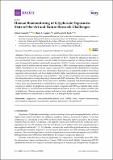Human biomonitoring of glyphosate exposures: State-of-the-art and future research challenges

View/
Date
2020-08-18Author
Connolly, Alison
Coggins, Marie A.
Koch, Holger M.
Metadata
Show full item recordUsage
This item's downloads: 110 (view details)
Cited 10 times in Scopus (view citations)
Recommended Citation
Connolly, Alison, Coggins, Marie A., & Koch, Holger M. (2020). Human biomonitoring of glyphosate exposures: State-of-the-art and future research challenges. Toxics, 8(3), 60. doi:10.3390/toxics8030060
Published Version
Abstract
Abstract: Glyphosate continues to attract controversial debate following the International Agency
for Research on Cancer carcinogenicity classification in 2015. Despite its ubiquitous presence in
our environment, there remains a dearth of data on human exposure to both glyphosate and its
main biodegradation product aminomethylphosphonic (AMPA). Herein, we reviewed and compared
results from 21 studies that use human biomonitoring (HBM) to measure urinary glyphosate and
AMPA. Elucidation of the level and range of exposure was complicated by differences in sampling
strategy, analytical methods, and data presentation. Exposure data is required to enable a more robust
regulatory risk assessment, and these studies included higher occupational exposures, environmental
exposures, and vulnerable groups such as children. There was also considerable uncertainty regarding
the absorption and excretion pattern of glyphosate and AMPA in humans. This information is required
to back-calculate exposure doses from urinary levels and thus, compared with health-based guidance
values. Back-calculations based on animal-derived excretion rates suggested that there were no health
concerns in relation to glyphosate exposure (when compared with EFSA acceptable daily intake
(ADI)). However, recent human metabolism data has reported as low as a 1% urinary excretion rate
of glyphosate. Human exposures extrapolated from urinary glyphosate concentrations found that
upper-bound levels may be much closer to the ADI than previously reported.

